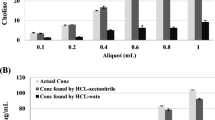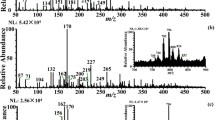Abstract
Estimating dietary choline intake can be challenging due to missing foods in the current United States Department of Agriculture (USDA) database. The objectives of the study were to quantify the choline-containing moieties and the total choline content of a variety of pulses available in North America and use the expanded compositional database to determine the potential contribution of pulses to dietary choline intake. Commonly consumed pulses (n = 32) were analyzed by hydrophilic interaction liquid chromatography-tandem mass spectrometry (HILIC LC-MS/MS) and compared to the current USDA database. Cooking was found to reduce the relative percent from free choline and increased the contribution of phosphatidylcholine to total choline for most pulses (P < 0.05). Using the expanded database to estimate choline content of recipes using pulses as meat alternatives, resulted in a different estimation of choline content per serving (±30 %), compared to the USDA database. These results suggest that when pulses are a large part of a meal or diet, the use of accurate food composition data should be used.

Similar content being viewed by others
Abbreviations
- AI:
-
adequate intake
- ARIC:
-
Atherosclerosis Risk in Communities
- HILIC LC-MS/MS:
-
Hydrophilic interaction liquid chromatography-tandem mass spectrometry
- IOM:
-
Institute of Medicine
- MEC:
-
Multiethnic cohort
- MRM:
-
Multiple reaction monitoring
- NL:
-
Neutral loss scan
- Pre:
-
Precursor ion scan
- RCF:
-
Relative centrifuge force
- USDA:
-
United States Department of Agriculture
References
Zeisel SH (2006) Choline: critical role during fetal development and dietary requirements in adults. Annu Rev Nutr 26:229–250
Institute of Medicine (1998) Dietary reference intakes for thiamin, riboflavin, niacin, vitamin B6, folate, vitamin B12, pantothenic acid, biotin and choline. Vol. 1. National Academies Press, Washington, DC
Bidulescu A, Chambless LE, Siega-Riz AM, Zeisel SH, Heiss G (2007) Usual choline and betaine dietary intake and incident coronary heart disease: the Atherosclerosis Risk in Communities (ARIC) study. BMC Cardiovasc Disord 7:20
Chiuve SE, Giovannucci EL, Hankinson SE, Zeisel SH, Dougherty LW, Willett WC, Rimm EB (2007) The association between betaine and choline intakes and the plasma concentrations of homocysteine in women. Am J Clin Nutr 86(4):1073–1081
Cho E, Zeisel SH, Jacques P, Selhub J, Dougherty L, Colditz GA, Willett WC (2006) Dietary choline and betaine assessed by food-frequency questionnaire in relation to plasma total homocysteine concentration in the Framingham Offspring Study. Am J Clin Nutr 83(4):905–911
Yonemori KM, Lim U, Koga KR, Wilkens LR, Au D, Boushey CJ, Le ML, Kolonel LN, Murphy SP (2013) Dietary choline and betaine intakes vary in an adult multiethnic population. J Nutr 143(6):894–899
Guerrerio AL, Colvin RM, Schwartz AK, Molleston JP, Murray KF, Diehl A, Mohan P, Schwimmer JB, Lavine JE, Torbenson MS, Scheimann AO (2012) Choline intake in a large cohort of patients with nonalcoholic fatty liver disease. Am J Clin Nutr 95(4):892–900
Gossell-Williams M, Fletcher H, McFarlane-Anderson N, Jacob A, Patel J, Zeisel S (2005) Dietary intake of choline and plasma choline concentrations in pregnant women in Jamaica. West Indian Med J 54(6):355–359
Dalmeijer GW, Olthof MR, Verhoef P, Bots ML, van der Schouw YT (2008) Prospective study on dietary intakes of folate, betaine, and choline and cardiovascular disease risk in women. Eur J Clin Nutr 62(3):386–394
Mygind VL, Evans SE, Peddie MC, Miller JC, Houghton LA (2013) Estimation of usual intake and food sources of choline and betaine in New Zealand reproductive age women. Asia Pac J Clin Nutr 22(2):319–324
Konstantinova SV, Tell GS, Vollset SE, Ulvik A, Drevon CA, Ueland PM (2008) Dietary patterns, food groups, and nutrients as predictors of plasma choline and betaine in middle-aged and elderly men and women. Am J Clin Nutr 88(6):1663–1669
Cheng WL, Holmes-McNary MQ, Mar WH, Lien EL, Zeisel SH (1996) Bioavailability of choline and choline esters from milk in rat pups. J Nutr Biochem 7:457–464
Patterson KY, Bhagwat SA, Williams JR, Howe JC, Holden JM, Zeisel SH, Dacosta KA, Mar MH (2008) USDA database for the choline content of common foods, release 2. http://www.ars.usda.gov/SP2UserFiles/Place/12354500/Data/Choline/Choln02.pdf. Accessed 19 Apr 2012
Zeisel SH, Mar MH, Howe JC, Holden JM (2003) Concentrations of choline-containing compounds and betaine in common foods. J Nutr 133(5):1302–1307
Health Canada (2008) What is a food guide serving of meat and alternatives. Canada’s food guide. http://www.hc-sc.gc.ca/fn-an/food-guide-aliment/choose-choix/meat-viande/serving-portion-eng.php. Accessed 7 Apr 2013
Zhao YY, Xiong Y, Curtis JM (2011) Measurement of phospholipids by hydrophilic interaction liquid chromatography coupled to tandem mass spectrometry: the determination of choline containing compounds in foods. J Chromatogr A 1218(32):5470–5479
Xiong Y, Zhao YY, Goruk S, Oilund K, Field CJ, Jacobs RL, Curtis JM (2012) Validation of an LC-MS/MS method for the quantification of choline-related compounds and phospholipids in foods and tissues. J Chromatogr B Anal Technol Biomed Life Sci 911:170–179
Leterme P (2002) Recommendations by health organizations for pulse consumption. Br J Nutr 88(Suppl 3):S239–S242
Anderson JW, Major AW (2002) Pulses and lipaemia, short- and long-term effect: potential in the prevention of cardiovascular disease. Br J Nutr 88(Suppl 3):S263–S271
Anderson JW, Smith BM, Washnock CS (1990) Cardiovascular and renal benefits of dry bean and soybean intake. Am J Clin Nutr 70(3 Suppl):464S–474S
Zulet MA, Martinez JA (1995) Corrective role of chickpea intake on a dietary-induced model of hypercholesterolemia. Plant Foods Hum Nutr 48(3):269–277
Sihag N, Kawatra A (2003) Hypolipidemic effect of pulse seed coats in rats. Plant Foods Hum Nutr 58:1–10
Phillips RD (1993) Starchy legumes in human nutrition, health and culture. Plant Foods Hum Nutr 44(3):195–211
Mudryj AN, Yu N, Hartman TJ, Mitchell DC, Lawrence FR, Aukema HM (2012) Pulse consumption in Canadian adults influences nutrient intakes. Br J Nutr 108(Suppl 1):S27–S36
Ofuya Z, Akhidue V (2005) The role of pulses in human nutrition: a review. J Appl Sci Environ Manag 9(3):99–104
Leterme P, Carmenza ML (2002) Factors influencing pulse consumption in Latin America. Br J Nutr 88(Suppl 3):S251–S255
Acknowledgments
The authors acknowledge the technical assistance of Yeping Xiong. This work was supported by Alberta Innovates Bio Solutions, Alberta Livestock and Meat Agency and Alberta Egg Producers. E. Lewis was the recipient of a studentship from the Women and Children’s Health Research Institute (WCHRI) at the University of Alberta.
Conflict of Interest
The authors declare that they have no conflict of interest.
Human or Animal Study
This article does not contain any study with animal subjects.
Author information
Authors and Affiliations
Corresponding author
Electronic supplementary material
Below is the link to the electronic supplementary material.
ESM 1
(PDF 108 kb)
Rights and permissions
About this article
Cite this article
Lewis, E.D., Kosik, S.J., Zhao, YY. et al. Total Choline and Choline-Containing Moieties of Commercially Available Pulses. Plant Foods Hum Nutr 69, 115–121 (2014). https://doi.org/10.1007/s11130-014-0412-2
Published:
Issue Date:
DOI: https://doi.org/10.1007/s11130-014-0412-2




